Cards In This Set
| Front | Back |
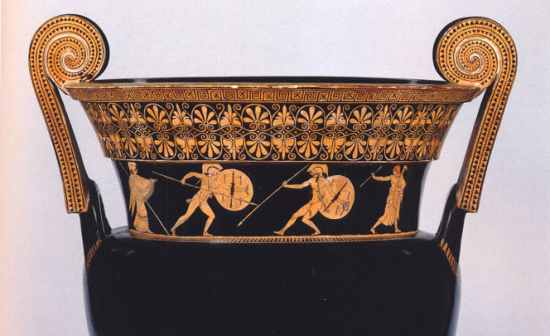 |
Achilles fighting the Trojan prince Hector. In the centre of this fireze like composition Achilles advances tot he right (the lucky side in the Greek art) against the greatest Trojan warrior, Hekctor. Beyond the duelling heroes are their patron deities: Athena urging on her favourite Achilles, and Apollo abandoning Hector to his inevitable fate.Athenian vase painters were familiar witht the Iliad because it was recited in its entirety every four years at the civic and religious festival of the Panathenaia.
|
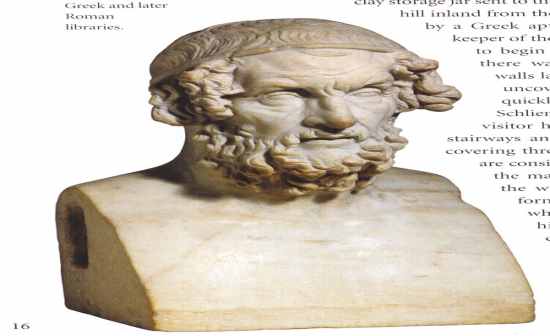 |
Marble portrait bust of Homer, Roman
Also from Townley's collection, this version of Homer's likeness is probably the one mentioned by Pliny as commisioned by the famous library of the Hellenistic city of Pergamon. Because Homer lived in the eight centry BC before ralistic portraiture was the norm, a portrait had to be invented in later times. As the composer of the two greatest Greek epics Iliad and Odyssey, Homer was an essential component of Greek and later Roman libraries. |
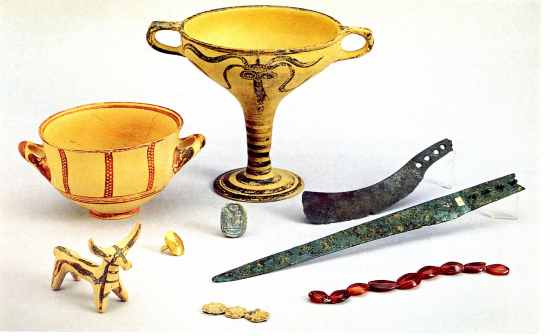 |
Group of Mycenaean finds from chamber tombs excavated in Ialysos on Rhodes. The Egyptian faience scarab in the centre of this group of objects provides what arcaeoligsts call a terminus post quem, or fixed date after which the objects are to be dated
|
 |
Linear B clay tablets. Foud by Arthur Evands at Knossos, these tablets record offerings of olive oil to various deites (top) and numbers of sheep at Phaistos (below). On the larger one the shepherd's name appears first in large characters, followed byt he name of the district where the flock was kept, the ideograms for rams and ewes, and the number of each. This indicates the wide-ranging administrative control exercised by Knossos over flocks grazing as far as 50km away.
|
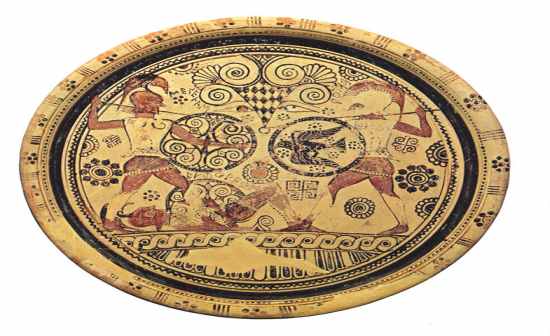 |
Rhodian plate with Meneleus and Kector fighting over teh body of Euphorbos. Although the scene is mythological, these warriors are equipped with full hoplite panoply: crested helmets, short thrusting spears, round shields or hople, corselets and greaves. Hoplites were obliged to provide not only their own armour but also their rations and bedding.
|
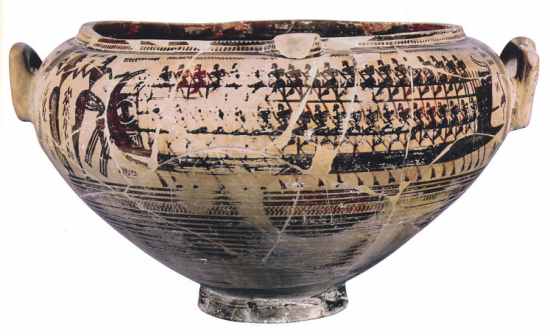 |
Late Geometric spouted krater with a multi-oared ship. Although this scene is often interpreted as mythological, such as Theseuss abducting Ariadne from Crete or paris kidnapping Helen, it could also simply depict a common occurrence in eights-century Greece, namely a Greek seafarer snatching a foreign bride. The wreath she hold suggests nuptials, and the shield in the hold of the ship indicates his warrior status.
|
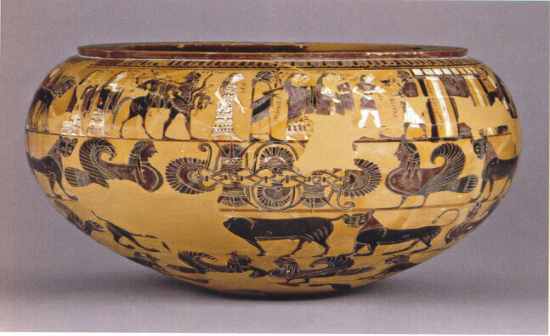 |
Wedding of Thetis and Peleus. Athenian black-figure dinos (bowl) signed by Sophilos. A procession of divinities on foot and riding in chariots encircles the top zone of this mixing bowl for wine and water. THey are en route to celebrate the nuptial s of the future parents of the hero Achilles, his mother Thetis who sits inside the house at the right and his father Peleus whi is greeting the guests.
|
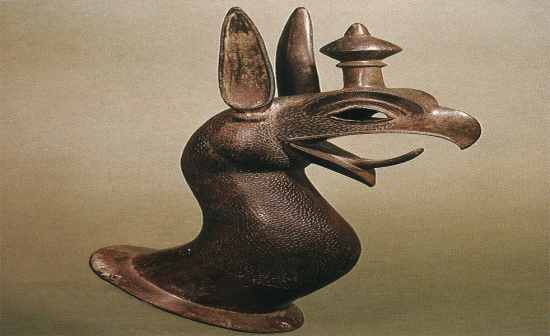 |
Bronze griffin head once attached to the rim of a cauldron. The curved base with attachement holes indicates that this hollow-cast bronze griffin was once attached to the shoulder of a bronze bowl. Its function was probably apotropaic, that is , to ward off evildoers from the sanctuary where it was dedicated.
|
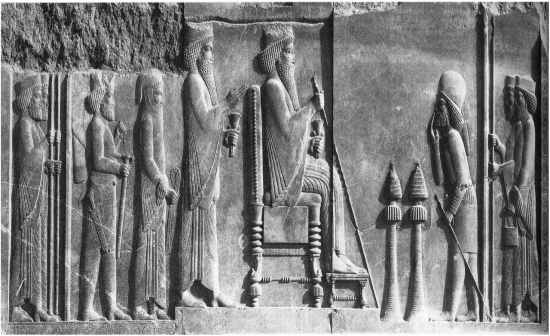 |
shows a king receiving an important official, who performs the ritual greeting that is known as proskynesis. Several figures are standing to the left and right. Darius sitting at the throne, behind him crown king Xerxes, The man saluting the king is probably the major of the palace, Pharnaces. He announces the arrival of the tribute carriers, who are represented on the wall near the stairs.
|
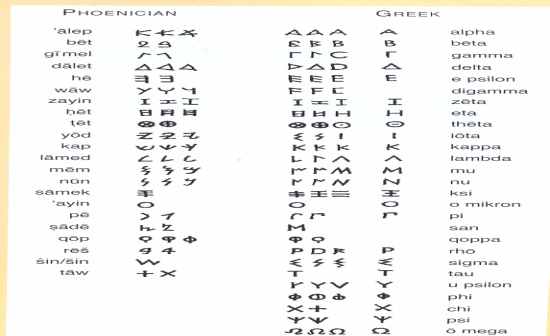 |
Accordint to Herodotus, the Greeks learned to write from the Phoeanicians, and he further states that the Greeks called their letters phoinikeia or Phoneceia or Phoenician things. Both the manner in which the letters are written and their order from alpha to tau confirm this derivation. As one can see the transformation from Semitic script to Greek there is pronounced tendency to make the letter forms more vertical and rectilinear thus conforming better to the prevailing Geometric style decoration. The Greeks needed fewer consonants thatn the Phoenicians and so changed some letters to vowels, which are lacking in Semitic scripts. In addition they invented new signs for double consonants and added them on at the end.
|
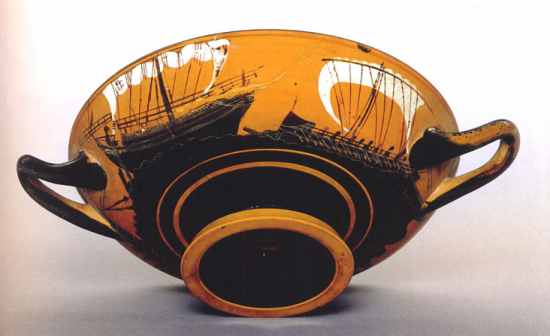 |
Two Greek ships. Athenian black figure kylix attributed to the Leagros Group. The prow of a deep- bellied merchant ship at the left is about to be rammed by an oared galley at the right. Note the long boar's snout, made of bronze at the prow of the man-o-war. Piracy was very common in the ancient Mediterranean and even at times considered a respectalbe way of earning a living.
|
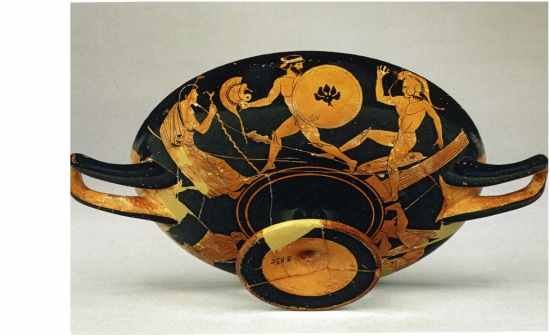 |
Hoplitodromos or race in armour. Athenian red-figure cup. Tow armed runners approach a judge after passing the turning post at hte right. The winner is looking back the runner-up who has dropped his shield.
|
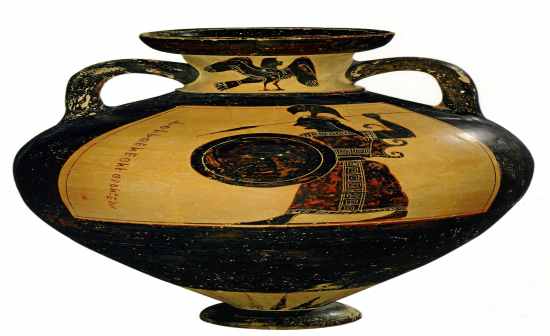 |
Panathenaic prize amphora. Known as Burgon Amphora because it was found by Thomas Burgon in an ancinet cemetery in Athens where it served as an ash urn, this large oil jar perhaps was awarded to a victorious equestrian in the games held in 562 or 558BC. On this side the goddess Athena is shown striding to the left where on reads the prize inscription 'one of the prizes at Athens'. The other side shows a man racing a two- horse cart.
|
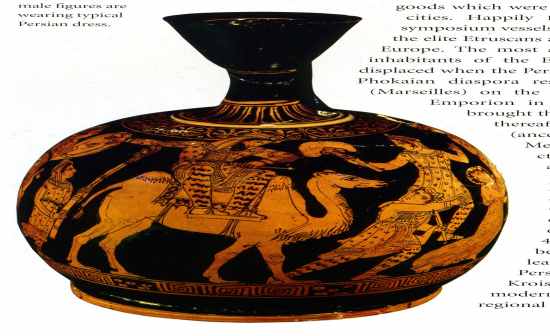 |
Persian riding a camel. Athenian red-figure squat lekythos. The Athenians probably first encountered camels when the perisans used them in their invasion of mailnd Greece in the early fifth century. THis exotic beast of burden is shown in what look like a Dionysian procession with dancing women. but hte male figures ar wearing typical Persian dress.
|
 |
Zeus giving birth to Athena. Athenian red-figure pelike. A dimunitive athena is shown popping out of the head of her father Zeus at the moment of her birth. An ancient hymn. Oresteia trial of Orestes evidence that mother is not of same blood.
|



